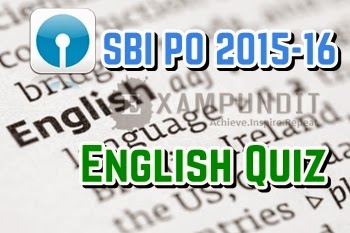Hello and welcome to ExamPundit. Here is a reading comprehension quiz for SBI PO Mains 2015.
Direction (Q. 1 – 10) : Read the following passage carefully
and answer the questions given below it.
and answer the questions given below it.
The saga of the International Organization for
Standardization (ISO) series of certification in India has come a long way.
From a mere handful of companies certified in 1990, today there are about 3000
which have achieved this distinction. This neo-elite group includes not only
the giant public sector Indian Oil Corporation, Government of India ordinance
factories, or mega-size private sector companies like Reliance, Tisco and
Larsen & Toubro, but also relatively small companies like the food
processing unit, Choice. The radius of ISO 9000 certification has now touched
sectors beyond manufacturing to cover services. In the beginning, ISO
certification was seen as a competitive advantage; now, with most of companies
having it, not having the certification is seen as a competitive disadvantage.
Gone are the days when the prime objective of ISO certification was as a
passport to exports to the European Union (EU).Today, it is seen as a seal of
quality to create the right image in the marketplace. This has stimulated many
a corporate to resort to standard systems of quality in manufacturing to ensure
that the end-user gets consistent quality at all times. ISO 9000 certification
comes into the picture at this point. Basically, a certification that documents
processes which conform to those required to produce goods or
deliver services of a consistent predetermined standard quality, the ISO 9000
series is the basis for a third party quality system registration programme.
Obtaining ISO certification ensures that a company has standardized quality
assurance and management systems at every level, and so the quality of a
product is consistent at any time. IS/ISO9000 or ISO 9000, as
a generic term, represents five different standards, namely, ISO 9000, ISO
9001/2/3 and ISO 9004 as per following details. ISO 9001: A system for quality
assurance in design/development, production, installation and servicing. ISO
9003: A system for assurance in final inspection and testing. Applies to
organizations with no design or manufacturing facilities, but which purchase
components from subcontractors and assemble and test them, and sell finished
products to customers. ISO 9004: Quality management and quality systems
guidelines .Obtaining ISO certification involves an assessment by
a company of its systems relative to ISO standards, and an independent auditor
certifying that the process and systems followed conform to the appropriate
standard (ISO 9001/2/(c) accepted internationally. Apparently, there are three
motives for going in for ISO certification for Indian as well as global
corporates. First, some corporates, especially those that survive on exports to
the EU, fear barriers in Europe and want an assured market.
Second, there are those companies pursuing ISO standards on demand from their
customers. And third, there are those who want to use ISO as a marketing tool
in the domestic market. However, in the final analysis, an ISO certified
company can reap the benefit of improved quality of products/ services .Such
certification may make customers feel more comfortable about the quality of a
supplier’s product. ISO-certified companies can also hope to observe a
reduction in the number of customer grievances.
Standardization (ISO) series of certification in India has come a long way.
From a mere handful of companies certified in 1990, today there are about 3000
which have achieved this distinction. This neo-elite group includes not only
the giant public sector Indian Oil Corporation, Government of India ordinance
factories, or mega-size private sector companies like Reliance, Tisco and
Larsen & Toubro, but also relatively small companies like the food
processing unit, Choice. The radius of ISO 9000 certification has now touched
sectors beyond manufacturing to cover services. In the beginning, ISO
certification was seen as a competitive advantage; now, with most of companies
having it, not having the certification is seen as a competitive disadvantage.
Gone are the days when the prime objective of ISO certification was as a
passport to exports to the European Union (EU).Today, it is seen as a seal of
quality to create the right image in the marketplace. This has stimulated many
a corporate to resort to standard systems of quality in manufacturing to ensure
that the end-user gets consistent quality at all times. ISO 9000 certification
comes into the picture at this point. Basically, a certification that documents
processes which conform to those required to produce goods or
deliver services of a consistent predetermined standard quality, the ISO 9000
series is the basis for a third party quality system registration programme.
Obtaining ISO certification ensures that a company has standardized quality
assurance and management systems at every level, and so the quality of a
product is consistent at any time. IS/ISO9000 or ISO 9000, as
a generic term, represents five different standards, namely, ISO 9000, ISO
9001/2/3 and ISO 9004 as per following details. ISO 9001: A system for quality
assurance in design/development, production, installation and servicing. ISO
9003: A system for assurance in final inspection and testing. Applies to
organizations with no design or manufacturing facilities, but which purchase
components from subcontractors and assemble and test them, and sell finished
products to customers. ISO 9004: Quality management and quality systems
guidelines .Obtaining ISO certification involves an assessment by
a company of its systems relative to ISO standards, and an independent auditor
certifying that the process and systems followed conform to the appropriate
standard (ISO 9001/2/(c) accepted internationally. Apparently, there are three
motives for going in for ISO certification for Indian as well as global
corporates. First, some corporates, especially those that survive on exports to
the EU, fear barriers in Europe and want an assured market.
Second, there are those companies pursuing ISO standards on demand from their
customers. And third, there are those who want to use ISO as a marketing tool
in the domestic market. However, in the final analysis, an ISO certified
company can reap the benefit of improved quality of products/ services .Such
certification may make customers feel more comfortable about the quality of a
supplier’s product. ISO-certified companies can also hope to observe a
reduction in the number of customer grievances.
1. Which of the following facts is true as per the
passage?
passage?
(a) The ISO 9000 standards are applicable to all types of
organizations.
organizations.
(b) The ISO 9000 standards provide frame work only for
Pollution prevention and waste reduction.
Pollution prevention and waste reduction.
(c) The ISO series of certification includes steps designed to prevent problems before they occur and to correct deviations
as soon as they are detected.
as soon as they are detected.
(d) India is a signatory to WTO.
(e) None of these
2. Why standards matter?
(a) ISO enables a consensus to be reached on solutions.
(b) When products, systems, machinery and devices work well
and safely, it is often because they meet standards.
and safely, it is often because they meet standards.
(c) Standards ensure desirable characteristics of products
and services such as quality, safety, reliability, compatibility, efficiency,
environmental friendliness and interchange ability – and at an economical cost.
and services such as quality, safety, reliability, compatibility, efficiency,
environmental friendliness and interchange ability – and at an economical cost.
(d) Both (b) and (c)
(e) All of the above.
3. What is the main role of ISO?
(a) Implement the requirements in the various activities and
processes adding value to some processes and activities.
processes adding value to some processes and activities.
(b) To promote the development of standardization and
related activities in the world with a view to facilitating international
exchange of goods and services, and to developing cooperation in the spheres of
intellectual, scientific, technological and economic activity.
related activities in the world with a view to facilitating international
exchange of goods and services, and to developing cooperation in the spheres of
intellectual, scientific, technological and economic activity.
(c) ISO is only responsible for the development of ISO 9000
standards. .
standards. .
(d) It contains a set of requirements to define the operation of the Environmental Management System.
(e) All of the above
4. What is the difference between ISO 9000 standards and
IS/ISO 9000 standards?
IS/ISO 9000 standards?
(a) ISO 9000 standards ensure quality of product while
another ensure quality of service.
another ensure quality of service.
(b) There is no difference. They are exactly the same.
(c) The IS/ISO 9000 standards are applicable to all types of
organizations while ISO 9000 standards are applicable to restricted
organisations.
organizations while ISO 9000 standards are applicable to restricted
organisations.
(d) All of the above
(e) None of these
5. What is the main benefit of implementing ISO 9003?
(a) Attention to resource management.
(b) Better management control.
(c) Implementation of statutory and regulatory requirements
related to product/services.
related to product/services.
(d) Creation of improved community goodwill.
(e) None of these
Direction (Q. 6 -7): Choose the word which is MOST
SIMILAR in meaning to the word printed in bold as used in the
passage.
SIMILAR in meaning to the word printed in bold as used in the
passage.
6. Stimulated
(a) Recourse (b) calm (c) excited (d) turn on (e) perceived
7. Assessment
(a) Evaluation (b) susceptible (c) spontaneous (d)
prevalence (e) comply
prevalence (e) comply
Direction (Q. 8 -10): Choose the word which is MOST
OPPOSITE in meaning to the word printed in bold as given below:
OPPOSITE in meaning to the word printed in bold as given below:
8. Conform
(a) Reckoning (b) constraints (c) considerable (d) Disagree (e)
predict
predict
9. Consistent
(a) Homogeneous (b) incompatible (c) regular (d) oppose (e)
integrated
integrated
10. Assured
(a) Distrustful (b) settled (c) clinched (d) stringent (e)
targeted
targeted
Regards
Team ExamPundit
Sponsored
(adsbygoogle = window.adsbygoogle || []).push({});
Books For 2015 Banking/Insurance Exams
This post was last modified on November 27, 2017 9:01 am





